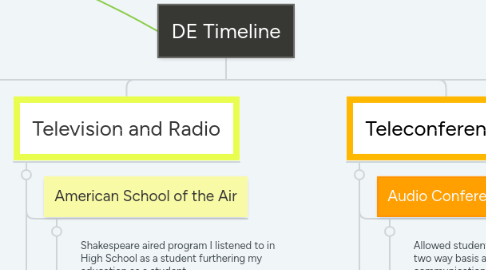
1. Theory
1.1. Independent Study- Charles Wedemeyer
1.1.1. Allows me as a student to learn through my own mediums, by textbooks, internet, and through my own methods
1.1.2. The greater responsibility for learning causes deeper and better introspection for higher level thinking
1.2. Transactional Distance
1.2.1. As a student I can be less dependent on my teacher and allow myself to learn autonomously
1.3. Synthesis of Existing Theories
1.3.1. I as a teacher can use DE to reach my students when away with a substitute or other means
1.3.2. Reminds me as a teacher to use multimedia approach
1.4. Andragogy
1.4.1. Weekly meetings in this class as a student allow me to see and hear what is being taught
1.4.2. DE classes I take have large amounts of quantitative and qualitative evaluations
1.5. Interaction and Communication
1.5.1. I take these classes and pursue this degree to learn and therefore my emotional involvement allows me to feel pleasure learning
1.5.2. DE encourages me to search, criticize and identify positions
2. Internet
2.1. AIM Project
2.1.1. First total system for DE
2.1.2. Set the expectation for study guides, tutoring and local library resources that I utilize as a DE student
2.2. Open Universities
2.2.1. UK Open University develops largest fully funded large enrollment program 1967 these systems could be used by Auburn to have financially productive DE classes
2.2.2. USAFI opens as a response for civilian education institutions to train troops these impacted me by creating courses that were built upon for later ones like the one I am taking
3. Mail/Correspondence
3.1. College Instruction
3.1.1. Illinois Wesleyan offering bachelor's master's and doctoral degrees starting the idea for DE degrees like the masters degree I am pursuing
3.2. Moody Bible Institute
3.2.1. Helped eliminate borders of where one can learn from as I am in Texas and learning from Alabama
3.2.2. Institute is still continuing today to provide education
3.3. Land Grant
3.3.1. Developed distance teaching by moving away from Old World values
3.3.2. Enrolled 2 million in 1930
3.3.3. 1862 Morril Act for people of all backgrounds like my students that I teach
4. References
4.1. Moore, M. G., Kearsley, G. (2012). Distance education: A systems view of online learning (3rd ed.). Belmont, CA: Wadsworth
4.2. Simonson, M., Smaldino, S. & Zvacek, S. (Eds.). (2012). Teaching and learning at a distance: Foundations of distance education (6th ed.). Charlotte, NC: Information Age Publishing.
5. Television and Radio
5.1. American School of the Air
5.1.1. Shakespeare aired program I listened to in High School as a student furthering my education as a student
5.1.2. NBC sponsorship beginnings
5.2. Early 1900's
5.2.1. Beginning of Educational Programs
5.2.2. NBC and CBS broadcast classes
5.2.3. Ford donates hundred of millions for grants
5.2.4. Programs and informational items created used by teachers today, there are several community television shows that teach citizenship I use
5.3. Satellites and Cable
5.3.1. FCC required all cable operators to have educational channel
5.3.2. 1,000+ postsecondary education institutions created for Corporations for Public Broadcasting creating interest in Universities like Auburn to open DE Courses that I take
6. Teleconferencing
6.1. Audio Conferencing
6.1.1. Allowed students to communicate on a two way basis as only one way communication had existed before, which is how we are able to have the class we have
6.1.2. 95% of network time was for continuing or noncredit education
6.2. NUTN
6.2.1. 1982 one hundred DE programs developed
6.2.2. Flaws in the enrollment, production costs and support were recognized and fixed for later DE classes that helped dictate my DE classes support and fees

